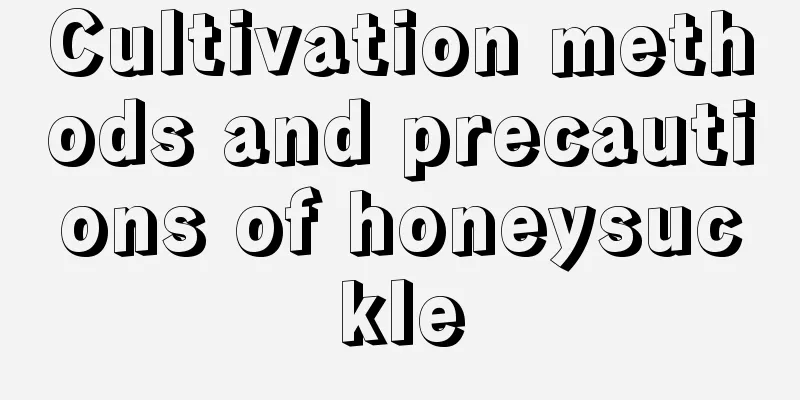Cultivation methods and precautions of honeysuckle

1. Maintenance methods1. Soil: It is suitable for growing in any soil. It has only one requirement for the soil, which is that the soil must have good drainage. If you use relatively sticky soil to grow it, you can add expanded clay to the soil to increase drainage. 2. Watering: For plants maintained in the open field, watering is generally not required unless it is dry weather. If the plant is in a state of drought for a long time, it is best to replenish it with water once a week. If it is a potted plant, it needs to be watered once every two to three days. Don't water too much each time, just water until the soil surface is moist. 3. Fertilization: No fertilizer is needed except during the growing period. During the growth period, nutrients are consumed quickly, so topdressing is needed to increase nutrients. The frequency of fertilization is twice a month. When fertilizing, you should choose fertilizers with richer ingredients. After fertilization, you need to water it immediately. One reason is to avoid fertilizer damage; the other is to allow the fertilizer to blend with the soil for easy absorption by the plant. 4. Light: Its growth cannot be separated from light. The daily light exposure time is at least five hours. If conditions permit, it is best to receive full-day sunlight. The plant needs to be rotated after being cared for for a period of time to prevent the sunny side from growing too tall. 2. Breeding techniques1. Reproduction: It can be propagated by sowing. When the fruits are ripe in October, peel them, dry them and store them. The sowing time is in March. Take out the seeds and soak them in warm water for half a day before sowing. When the seedlings grow to ten centimeters high, you can spray them with Bordeaux liquid to prevent damping-off disease. 2. Pruning: When pruning, keep some branches appropriately to increase the yield. In order to make the branches evenly distributed, you can cut off excess branches in the spring, cutting from the inside to the outside and dividing them into layers, which can also increase the yield. 3. Problem Diagnosis1. Pests: Aphids are pests that plants are more easily infected with. Aphids attack young leaves, causing them to curl and stop growing. If you find that the plants are infected with aphids, you can use aphidicide to eliminate the insects. 2. Diseases: Brown spot disease is common on the leaves of plants, which will weaken the growth of the plants. The peak period of the disease is in August and September every year because it is rainy and humid at this time. After the disease occurs, cut off the diseased leaves and then spray the plants with thiophanate-methyl for treatment. IV. Other issues1. Edibility: It is edible. In addition to being edible, it can also be used as medicine. 2. Toxicity: non-toxic. |
>>: Coral bell cultivation methods and precautions
Recommend
When is the right time to plant gourds?
Gourds are generally eaten as vegetables , but th...
Is dogtooth flower poisonous?
Is dogtooth flower poisonous? There is no clear r...
Seed propagation of Cassia winged pod
Selecting a seed If you are not shopping online, ...
Shandong radish planting time and method and when to harvest
Shandong radish planting time The planting time o...
How to grow pearl bush
Select pot For potted plants, use a 20-30 cm diam...
What flowers are suitable for growing in Zhengzhou? What are the city flowers and trees?
1. Climate characteristics of Zhengzhou Zhengzhou...
How to divide succulent plants by leaf cuttings
The division process Tools: Shovel, tweezers, bru...
How to prune Brazilian wood
When to prune Brazilian wood When is the best tim...
How to prepare succulent soil? How to prepare succulent soil
Succulent soil preparation requirements Succulent...
Causes and treatments for yellowing violet leaves
1. Poor air circulation Reason: Violets prefer a ...
Treatment for loss of appetite in sheep
The weather has been getting hotter recently. Som...
When and how to transplant the iron tree? How to transplant it so that it can survive easily
It is best to transplant the iron tree in spring ...
The difference between cherry tomatoes and tomatoes
1. Difference in appearance The roots of cherry t...
Recommended flowers for expressing love on Christmas Eve and Christmas
1. Confession of first love 1. Lilac If it is you...
How to grow butterfly flowers
Temperature requirements The suitable temperature...









